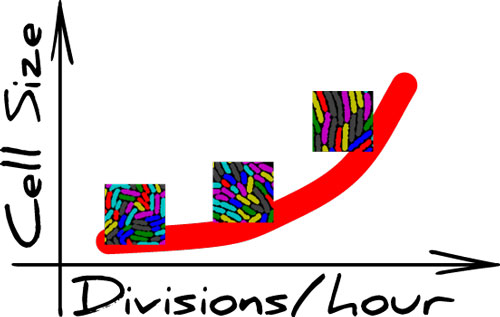Making sense of cell growth and division is a primary goal of biology. Decades of classic work give us a fairly clear understanding of the average behaviour of populations, but the behavior of single cells is often still unclear, as are the specific molecular mechanisms. In 1958, a classic experimental result by Schaechter, Maaloe, and Kjeldgaard established that the mean cell size of steadily dividing populations increased exponentially with the mean number of divisions per hour, independently of what the cells were specifically eating to grow and divide. This result allows production of populations of Escherichia coli or Salmonella bacteria with very different mean sizes, and for their behavior to be explored. The present study [Ref. 1] uses advanced microscopy techniques to ask how cell size and timing of cell division vary for all the single cells in a population. The authors ask if single cells obey the laws valid for population averages? The answer is no: individuals with equal interdivision times, but coming from two colonies with different nutrient conditions, generally tend to have different sizes.

Figure: Sketch of the trend of mean cell size with frequency of cell division for Escherichia coli bacteria. The squares contain actual pictures of microcolonies from the experiments in this work, which looked at bacteria one by one and over time. The colors are assigned by the automatic shape-recognition algorithm developed by the authors.
In contrast with this cell "individuality", the authors also find a parallel "universal" trend, which is that the probability distributions of both cell size and interdivision time across conditions are in fact the same distribution, when rescaled by their means. This kind of phenomenon is likely to have an ecological relevance. For example, a similar trend has been reported from a study looking at the size of 13 different protists and unicellular algae collected in a wide set of field conditions [Ref. 2]. It was found that single-species size distributions covering different phyla exhibit universal features over more than four orders of magnitude, leading researchers to wonder how ecological and physiological processes should interact to produce such “scale-invariant” size distributions independent of the species.
Using simulations and general theoretical arguments, which hold beyond specific models describing how E.coli cells divide, the authors are able to show that the same mechanism controlling cell division could be responsible for both the anomalous "individual" fluctuations and the “universal” distributions, which are, in fact, two sides of the same coin. They are implemented by specific constraints in the system that controls cell division to achieve size homeostasis. From the ecological viewpoint, this result suggests that while different species adopt a wide set of strategies to control the cell size, a sort of "higher" ecological/physiological principle sets the universality of their size distributions.
Reference
[1] Individuality and universality in the growth-division laws of single E. coli cells. Andrew S Kennard, Matteo Osella, Avelino Javer, Jacopo Grilli, Philippe Nghe, Sander J Tans, Pietro Cicuta, Marco Cosentino-Lagomarsino. Phys Rev E 93(1-1):012408 (2016).
Other references
[2] Scaling body size fluctuations. Andrea Giometto, Florian Altermatt, Francesco Carrara, Amos Maritan, and Andrea Rinaldo. Proc. Natl. Acad. Sci. (U.S.A.) 110, 4646-50 (2013).


































